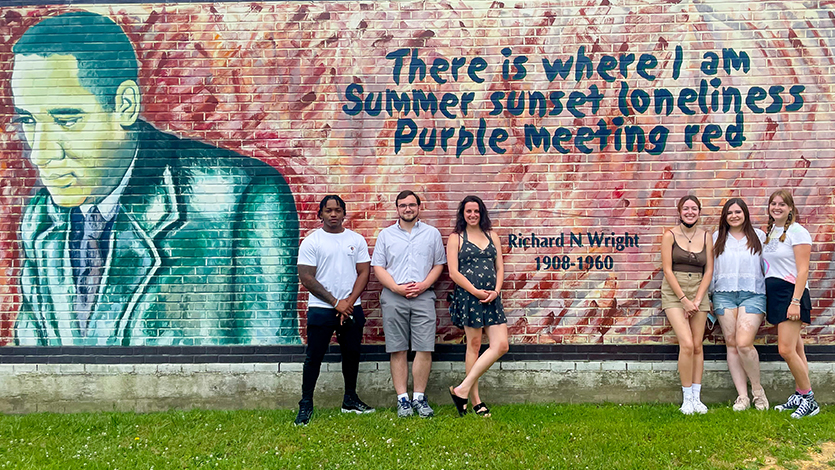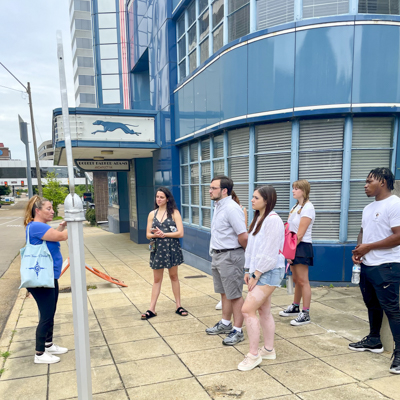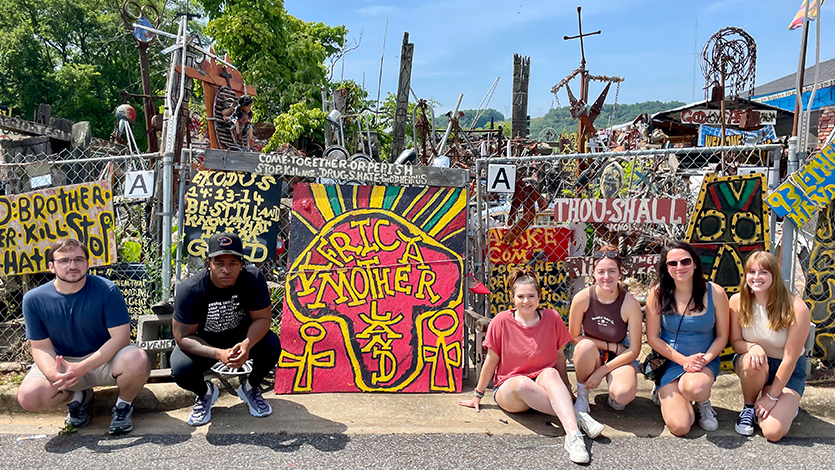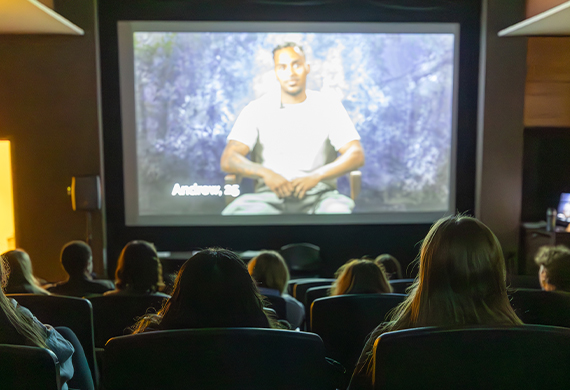Students Explore African American History in the American South

Six history students guided by Dr. Rosen and Dr. Garabedian translated their classroom education to living history sites with their trip to the American South, where they visited multiple historic sites related to the Black Freedom Struggle.
June 29, 2021—Students from Marist’s History Department course 'The Struggle for Racial Justice in the South' led by professors Dr. Robyn Rosen and Dr. Steve Garabedian, recently went on an inspiring trip to the American South to visit multiple historical sites related to the Black Freedom Struggle.

The trip included a visit to the Emmett Till Interpretive Center in Sumner, Mississippi and a tour of the site of his murder and subsequent trial. Here, their tour guide was Jessie Jaynes-Diming, of the Emmett Till Memorial Commission, who has been working to commemorate the killing of Emmett Till. The Rosa Parks Museum in Montgomery, Alabama, showcased and offered important context for understanding and appreciating Mrs. Park’s courageous stand against segregation and discrimination. Students also learned about African American achievements in other arenas such as sports in the Negro Southern League Museum, which highlights the history of African American baseball.
Student and Faculty Reflections
“We followed the trail of Emmett Till's murder, from the barn where he was killed, to the river in which his body was found, to the courthouse where his murderers were acquitted,” said Rosen. “We also visited the Greyhound station in Jackson, Mississippi, where the Freedom Riders made their stand, and Kelly Ingram Park in Birmingham where children faced police dogs—incredible acts of bravery that helped to transform our nation.”
Rising senior, Olivia McMahon, reflects on the trip as an experience she will never forget. “I was fortunate enough to go on what was easily the most moving, important, heavy, and honest trip I’ve ever taken. Coming away from this trip and seeing the history of the injustices that took place not only in the American South, but across the nation has marked a life changing experience for us as a class.”
- Olivia McMahon ‘22
The trip also included museum tours that focused on the musical and artistic history of African Americans and their influence through present time. "For the faculty and students, the trip was deeply moving and inspirational. In addition to museum and historic sites relating to the Black Freedom Struggle in the U.S., we also visited legendary music history locations," said Garabedian. "The Stax Museum of American Soul Music and the Rock 'n' Soul Museum, both in Memphis, were destinations that showed the ways in which oppressed communities can find empowerment and expression through the arts. African American music has become a global soundtrack to the modern age," Garabedian continued.

Students were inspired by a large collection of Black folk art created by Birmingham artist Joe Minter. (L-R) Nicholas Donahue ‘23, Arthur Pinckney ’22, Caitlyn Meyers ’22, Evelyn Milburn ’24, Oliva McMahon ’22, and Lydia Cheever ’22.
According to senior History major, Arthur Pinckney: “This trip was a life changing experience. We got to take a deeper look into some of the ugly truths that are buried within our country’s history. Mixing classroom education with the physical places where history took place is the best way to understand the history of the United States and how to best move forward and ensure the injustices don’t happen again. “This trip is illuminating to the mind, and I recommend it to anyone that would be interested.”
- Arthur Pinckney ‘22
Lydia Cheever summarizes the trip as providing many insights into some of the tragic aspects of our country’s history. “The trip provided an education I did not know I was missing and it is difficult now to not have a transformed and heightened perspective on current racial justice issues in our country. I believe that all of us were both enraged throughout the trip by the history we learned, but also were given a lot of hope by seeing that change is possible and that resistance takes many different forms.”
- Lydia Cheever ‘22
Nicholas Donahue reflects on his experience and the importance of seeing where this history took place first-hand. “The Equal Justice Initiative's (EJI) Legacy Museum and lynching memorial make it impossible to not stare history in the face. The National Peace and Justice Memorial, dedicated to the victims of racist terror in the United States, consists of metal slabs which list the names and dates of every known lynching victim in a given county, and there are hundreds of those slabs. This serves as a reminder that racism, and the inequalities and violence which constitute it, is not some ghost of the dead institutions of slavery or Jim Crow haunting the US, but is a very real part of so many people of color's lives today.”
- Nicholas Donahue ‘23
Evelyn Milburn contextualizes the relationship between racism in the United States with the cultural effect it has had in history. “Through the life, art, struggle, and song of African American heroes, we were reminded that racism was created as a concept to dehumanize and monopolize black labor and culture. Ethnic culture is vibrant in the South through family owned restaurants such as the Big Apple Inn, which houses Medgar Evers’ first field office for the NAACP.”
- Evelyn Milburn ‘24
“Getting out of the classroom and into places like Birmingham, Alabama, and the Mississippi Delta brought the history of African American resistance and suffering to life,” Rosen concluded.



